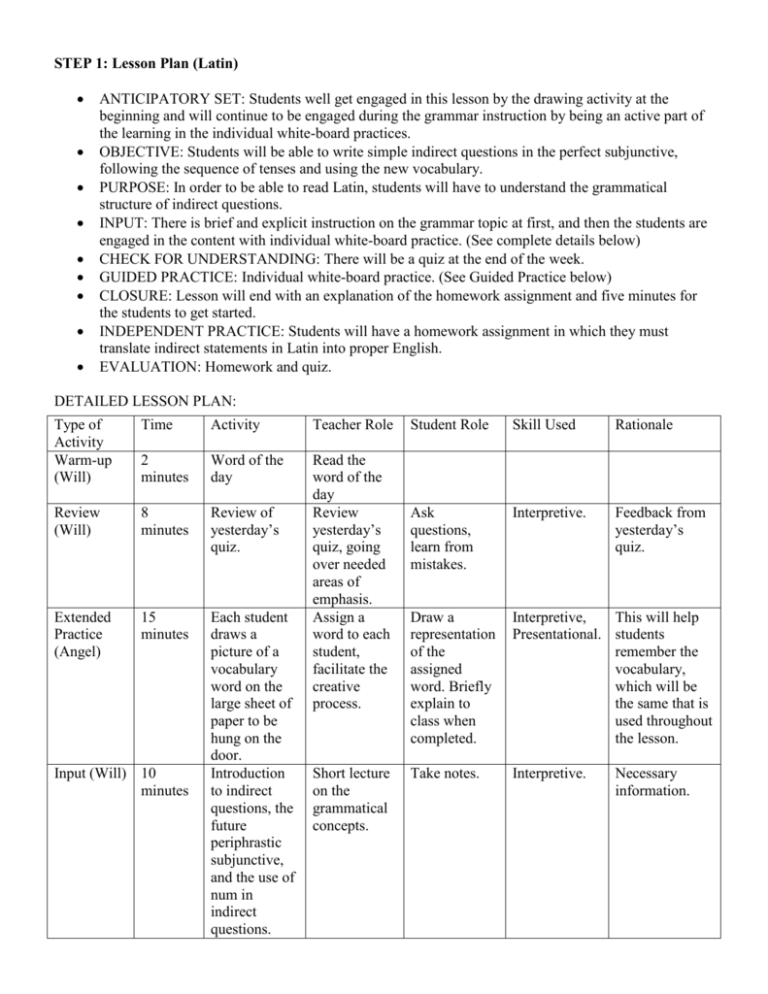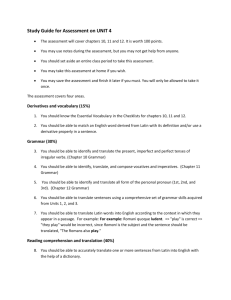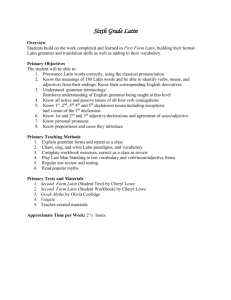STEP 1: Lesson Plan (Latin)
advertisement

STEP 1: Lesson Plan (Latin) ANTICIPATORY SET: Students well get engaged in this lesson by the drawing activity at the beginning and will continue to be engaged during the grammar instruction by being an active part of the learning in the individual white-board practices. OBJECTIVE: Students will be able to write simple indirect questions in the perfect subjunctive, following the sequence of tenses and using the new vocabulary. PURPOSE: In order to be able to read Latin, students will have to understand the grammatical structure of indirect questions. INPUT: There is brief and explicit instruction on the grammar topic at first, and then the students are engaged in the content with individual white-board practice. (See complete details below) CHECK FOR UNDERSTANDING: There will be a quiz at the end of the week. GUIDED PRACTICE: Individual white-board practice. (See Guided Practice below) CLOSURE: Lesson will end with an explanation of the homework assignment and five minutes for the students to get started. INDEPENDENT PRACTICE: Students will have a homework assignment in which they must translate indirect statements in Latin into proper English. EVALUATION: Homework and quiz. DETAILED LESSON PLAN: Type of Activity Warm-up (Will) Time Activity Teacher Role 2 minutes Word of the day Review (Will) 8 minutes Review of yesterday’s quiz. Extended Practice (Angel) 15 minutes Each student draws a picture of a vocabulary word on the large sheet of paper to be hung on the door. Introduction to indirect questions, the future periphrastic subjunctive, and the use of num in indirect questions. Read the word of the day Review yesterday’s quiz, going over needed areas of emphasis. Assign a word to each student, facilitate the creative process. Input (Will) 10 minutes Short lecture on the grammatical concepts. Student Role Skill Used Rationale Ask questions, learn from mistakes. Interpretive. Feedback from yesterday’s quiz. Draw a representation of the assigned word. Briefly explain to class when completed. Interpretive, This will help Presentational. students remember the vocabulary, which will be the same that is used throughout the lesson. Take notes. Interpretive. Necessary information. Guided practice (Will) 15 minutes Students practice writing indirect questions in Latin using their white boards. Give sentences to the students in English to be translated into Latin using the vocabulary that the students illustrated. Input (Angel) 5 minutes Introduce the perfect subjunctive, the use of utrum…an/necne, and the sequence of tenses. Short lecture on the grammatical concepts. Guided Practice (Angel) 15 minutes Students practice writing indirect questions in the perfect subjunctive in Latin using their white boards. Give sentences to the students in English to be translated into Latin using the vocabulary that the students illustrated. Assignment (Will) 5 minutes Give the homework assignment and go over examples from each section. Translate sentences into Latin. One student will write the sentence on the white board. The whole class will review. Take notes. Interpretive. Guided practice of the new grammar. Connection to prior learning by using the illustrated vocabulary. Interpretive. Translate sentences into Latin. One student will write the sentence on the white board. The whole class will review. Interpretive. Scaffolded grammatical instruction. This information builds on the previous concepts. Guided practice of the new grammar. Connection to prior learning by using the illustrated vocabulary. This builds on the previous guided practice – new grammar, same idea. STEP 2: INCLUDE Step 1. Classroom Demands STEP 3: INCLUDE Steps 2-7 T.J.: A student with a learning disability LEARNING STRENGTHS & NEEDS: T.J’s strengths lies in his ability to comprehend oral material. In addition, he learns well from visual aids, such as semantic maps. But, he is deficient in his reading and comprehending abilities. Because of this he has low self-esteem, which he tries to cover up by acting out in class. He also has difficulty planning and finishing his homework. AREAS OF LIKELY SUCCESS: T.J. will be able to succeed if he is taught with as much oral content as possible with the assistance of visual aids. POTENTIAL PROBLEMS: T.J. is likely to succeed when is not asked to read a lot of information. His reading comprehension is his main difficulty. He also struggles with putting words together. This lesson calls for doing some translating from English into Latin, reading to translate could be difficult and could cause him to slow down. Translating the sentences into Latin will be another challenge. In addition, there is a lot of grammar that is covered in this lesson. Though this is introduced orally, he may have difficulty keeping all of the nuances of Latin grammar straight. Finally, there is a homework assignment. T.J. struggles to do his homework on time. POSSIBLE ADAPTATIONS: T.J. would benefit from some grammar charts that are tailored to this lesson because visual representations help his understanding, this would help him follow the lecture and translate his sentences into Latin. When giving the sentences to translate into Latin, he would benefit by having them be repeated several times orally. When giving his Latin sentences, he would also benefit by being able to speak them rather than write them on his individual whiteboard. He may also need additional time for his homework. DIFFERENTIATE INSTRUCTION: We would differentiate this lesson plan we wrote by giving grammar charts that explain the day’s grammar lesson simply and clearly. These would be charts of the important grammar (i.e. the subjunctive mood), as well as visual maps of indirect questions, which would show how to form an indirect question in Latin as if were a formula (e.g. interrogative verb + question word + verb in the subjunctive), with examples of possible words listed below each heading. These would be distributed to all students so as not to isolate T.J. and do more harm to his low self-esteem. When we give the English sentences to be translated into Latin, we would write them on the board, but also repeat them several times slowly. T.J. is reluctant to be called on during class, so would not force this at first. But, when he gets more comfortable with the material, and it is apparent that he has a good understanding of the material, we would ask him to speak his translated sentence. If we call on him when we know he will be successful, he will build some confidence in him self. We would try to end the lesson five to ten minutes shorter, if possible, in order to give all of the students more time to work on their homework. During this time we would facilitate all of the students with their homework, but would keep an eye on T.J. in particular to make sure he has a good start on the assignment. T.J. may need additional help after class. Because a resource room would not likely benefit him in Latin, we would make ourselves available for 30 minutes after school. Assigning T.J. a tutor would also be a good idea. EVALUATION OF PROGRESS: We would evaluate T.J.’s progress in this lesson much like we would any other student’s: from in-class observation, completion of homework, and success on the quiz. However, T.J. would be allowed to have the quiz read to him, because his struggles in reading do not entirely reflect his ability to comprehend.







